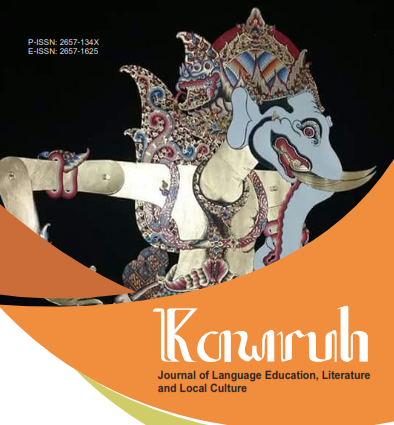A Focalization of Three Selected Short Stories from Noor. HD's Collection of Short Stories Taman Tanpa Aturan: A Narratological Study by Gerard Genette
Kajian Naratologi Gerard Genette
DOI:
https://doi.org/10.32585/kawruh.v7i1.7136Keywords:
Narrative, Genette, Focalization, Taman Tanpa AturanAbstract
A collection of short stories entitled Taman Tanpa Aturan by Noor H. Dee presents childern's imagination from the knowledge and symbols they encounter. The world of children filled with curiosity in Taman Tanpa Aturan is provided through high level of fantasy genre story. Three most interesting of twenty-four story titles in Taman Tanpa Aturan short story collection have been selected: 1) Rambut Jeruk Alma, 2) Gelembung Sabun, dan 3) Taman Tanpa Aturan. The three selected short stories raise questions about the influence of focalization (the narator's voice) on the delivery of the message. Using the narratology research by Gerard Genette, this research reveals the narrative technique used by Noor H. Dee in delivering messages to children through his work. The research data source from selected short stories in the short story collection Taman Tanpa Aturan. Using a qualitative descriptive method, the data in the from of words, phrases, and sentence in this study were analyzed using Gerard Genette's narrative technique consisting of duration, mood, and voice. The result of the data analysis in this study show that the message contained in the three short stories between the messages received by child readers and adult readers can have differences. The difference in message reception known through the narrative level which is in extradiegetic-heterodiegetic with zero focalization in the short story entiteld Rambut Jeruk Alma and Gelembung Sabun, and selective heterodiegetic in Taman Tanpa Aturan because the focalization is composed of a combination of zero and internal focalization.
Downloads
References
Akillah, A. Y. (2024). Nilai-Nilai Pendidikan dalam Novel Anak Kupetik Bintang Karya Rizky Nur Fajri: Kajian Sosiologi Sastra. Sarasvati, 6(1), 33–47.
Faruk, H. T. (2012). Metode penelitian sastra: sebuah penjelajahan awal. Pustaka Pelajar.
Genette, G. (1988). Narrative Discourse Revisited. Cornell University.
Herdiansyah, H. (2010). Metodelogi Penelitian Kualitatif. Jakarta: Penerbit Salemba Humanika.
Hobyane, R. S. (2022). Character focalisation and its function in the story of Susanna. HTS Teologiese Studies/Theological Studies, 78(1), 7641.
Huck, C. S. (1993). Children’s literature in the elementary school. ERIC.
Lukman, L. (2011). Proses Pembentukan Subjek: Antropologi Filosofis Jacques Lacan. PT Kanisius.
Magnis-Suseno, F. (1984). Etika Jawa. Sebuah Analisa Falsafi tentang Kebijaksanaan Hidup Jawa. Penerbit PT Gramedia.
Margana, S. (2004). Pujangga Jawa dan bayang-bayang kolonial. (No Title).
Muktiali, S., Edy, S., & Nenda, N. (2024). Peran Orang Tua dalam Pendidikan Karakter Gemar Membaca terhadap Anak Usia Sekolah Dasar. Jurnal Basicedu, 8(1), 499–509.
Muslimin, M. F., & Zaki, A. (2022). Antara Pembaca Anak atau Dewasa: Membuka Tabir Fiksi Semua Ikan di Langit: Between Children and Adult Readers: Uncovering Fiction Semua Ikan di Langit. TOTOBUANG, 10(2).
Nurgiantoro, B. (2018). Sastra Anak: Pengantar Pemahaman Dunia Anak. UGM PRESS. https://books.google.co.id/books?id=_ZtjDwAAQBAJ
Nurgiyantoro, B. (2018). Teori pengkajian fiksi. UGM press.
Piaget, J., & Cook, M. (1952). The origins of intelligence in children (Vol. 8, Issue 5). International universities press New York.
Pitari, P. (2022). In Defense of Literary Truth: A Response to Truth, Fiction, and Literature by Peter Lamarque and Stein Haugom Olsen to Inquire into No-Truth Theories of Literature, Pragmatism, and the Ontology of Fictional Objects. Literature, 3(1), 1–18.
Purnomowulan, N. R. (2016). Penulisan Sastra Anak: Sederhana Yang Tidak Mudah. Seminar Nasional Sastra Anak” Sastra Anak Dan Kreativitasnya”, Yogyakarta.
Ratna, N. K. (2022). Teori, metode, dan teknik penelitian sastra.
Sa’adah, S. I. (2018). Kajian naratologi genette dalam tiga cerita pendek pilihan kompas tahun 2000an. BASINDO: Jurnal Kajian Bahasa, Sastra Indonesia, Dan Pembelajarannya, 2(2), 119–125.
Sheikh, A. R., Munaf, M. A., & Sultan, A. (2022). Facets of Focalisation in James Joyce’s A Painful Case: A Narrative Analysis. Pakistan Journal of Humanities and Social Sciences, 10(4), 1668–1678.
Sukirman, S. (2021). Karya sastra media pendidikan karakter bagi peserta didik. Jurnal Konsepsi, 10(1), 17–27.
Sulyandari, A. K. (2021). Perkembangan Kognitif dan Bahasa Anak Usia Dini. Guepedia.
Teew, A. (1988). Sastra dan Ilmu Sastra: Pengantar Ilmu Sastra. Jakarta: Pustaka Jaya-Girimukti Pasaka.
Wahyuni, D. (2022). Pengaruh Minat Baca dan Motivasi Belajar Terhadap Prestasi Belajar Siswa Kelas X SMA PGRI 1 Jombang. Jurnal Pendidikan Edutama, 9(2), 231–240.
Zahro, A., & Indrastuti, N. S. K. (2024). Suara Naratif dalam Na Willa Karya Reda Gaudiamo: Perspektif Naratologi Gerard Genette. GHANCARAN: Jurnal Pendidikan Bahasa Dan Sastra Indonesia, 6(1), 53–70.
Zhang, E. (2021). Naratif dan Pendidikan Manusia Berdaya dalam Filsafat Paul Ricoeur. PT Kanisius.
Downloads
Published
How to Cite
Issue
Section
License
Copyright (c) 2025 Erlin Aryulita, Novi Siti Kussuji Indrastuti, Venny Indria Ekowati

This work is licensed under a Creative Commons Attribution-ShareAlike 4.0 International License.
Authors who publish with the Kawruh: Journal of Language Education, Literature and Local Culture agree to the following terms:
- Authors retain copyright and grant the journal the right of first publication with the work simultaneously licensed under a Creative Commons Attribution License (CC BY-SA 4.0) that allows others to share the work with an acknowledgment of the work's authorship and initial publication in this journal.
- Authors are able to enter into separate, additional contractual arrangements for the non-exclusive distribution of the journal's published version of the work (e.g., post it to an institutional repository or publish it in a book), with an acknowledgment of its initial publication in this journal.
- Authors are permitted and encouraged to post their work online (e.g., in institutional repositories or on their website) prior to and during the submission process, as it can lead to productive exchanges, as well as earlier and greater citation of published work.

